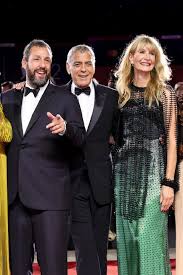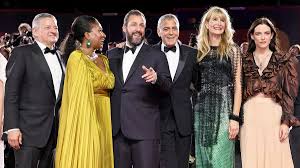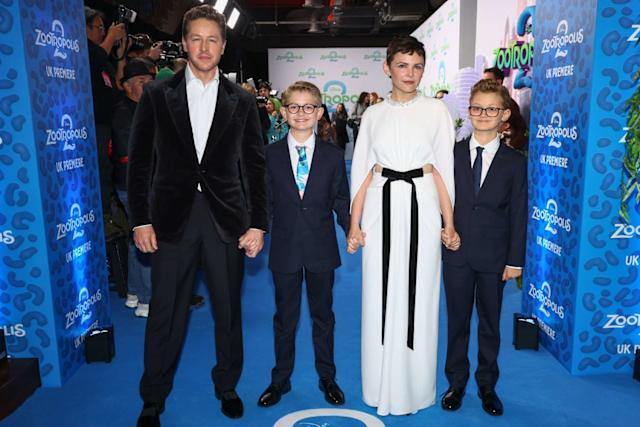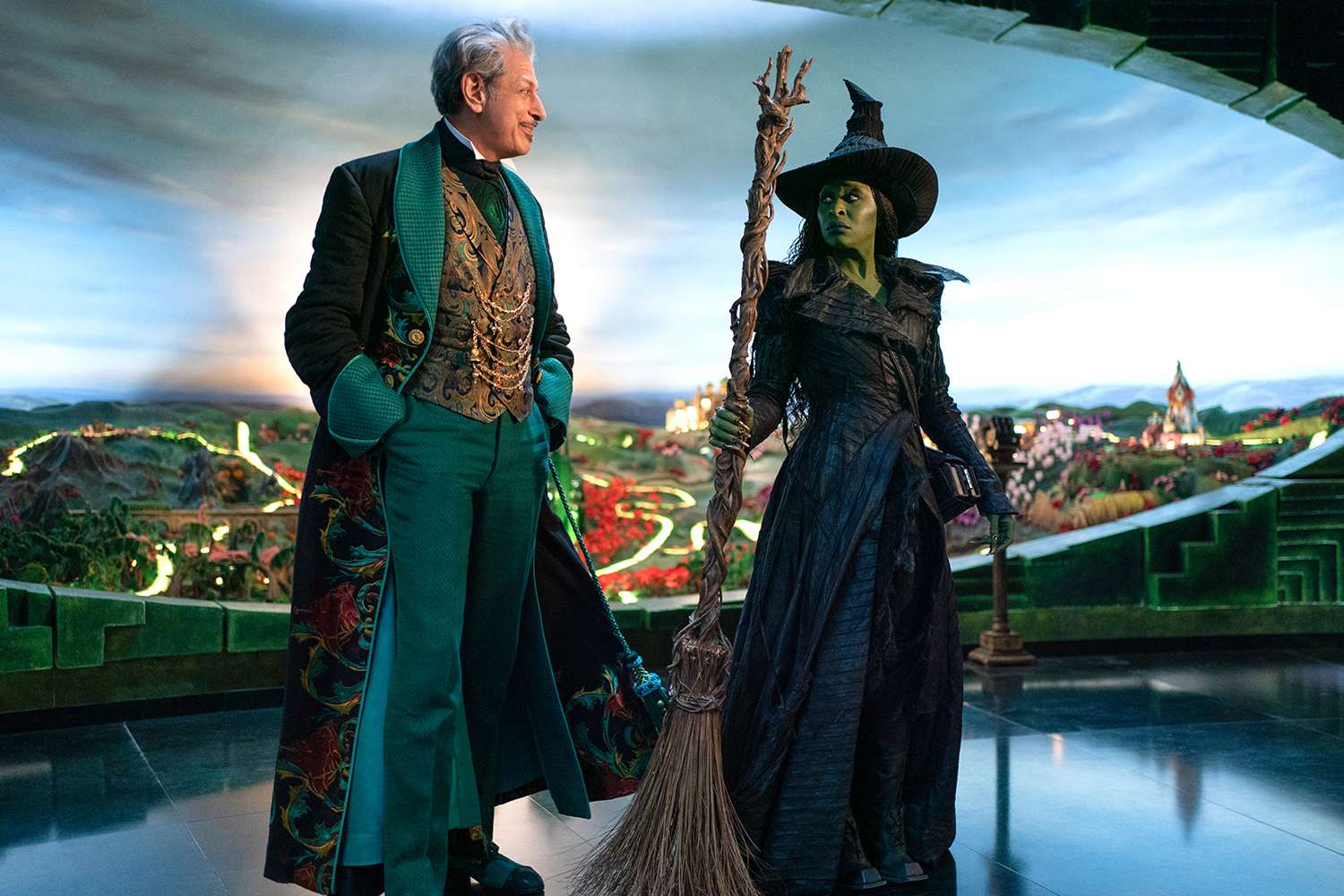It isn’t every day that you see Adam Sandler, the archetypal sweatshirt‑lover known for his easygoing, everyman charm, stepping out in a rare tuxedo with all the intention of looking—well, profoundly glamorous. Yet that’s precisely what happened on a warm evening in Venice, when, side by side with the effortlessly elegant George Clooney, Sandler helped turn heads in a moment that felt like the cinematic embrace of two worlds colliding: cheeky, grounded warmth rubbing shoulders with old‑Hollywood sleekness. It was more than just a red carpet appearance. It felt like an occasion.
The duo weren’t just there to look good though. This was the moment of truth for Jay Kelly, their collaboration with acclaimed director Noah Baumbach. The film, described in a neat blurb by Netflix as the story of a famous actor’s journey of self‑discovery—hounded by ghosts of the past, confronting the present, all while relying on his steadfast manager—was about to encounter its defining moment of vulnerability: the Venice Film Festival premiere. And Venice, as any cinephile will tell you, is not a place for half‑measures. It’s a place where guts meet grace, and where audience reactions can echo well beyond the lagoon.
What happened that evening was nothing short of flabbergasting. An 8.5‑minute standing ovation. Imagine nearly nine minutes of applause, of whistles, of real emotional energy bouncing across the Palazzo del Cinema. That’s roughly the time it takes for a short film to roll—only here, it was for a full‑length feature and for a cast who, in that moment, had managed to strike a chord. Sandler, playing the loyal manager whose life is wrapped up in the extraordinary journey of his client, and Clooney, playing the famously charismatic (and perhaps quietly unmoored) actor stepping into his own, had tapped into something the crowd needed. The festival crowd responded viscerally. The applause became a kind of embrace.
Picture the way Sandler must have felt, standing there in the sharp cut of a tuxedo, a break from his usual flannel or fleece, surrounded by global press flashes and murmurs of “Is that really… him?” But it wasn’t just Sandler absorbing the moment. Clooney, that effortlessly cool human, who—just hours earlier—had bowed out of the press conference with a sinus infection, was on his feet, healthy enough to shine where it counted. You could almost see the internal switch, twinkling behind his eyes: “I’m feeling a little rough, but nothing gets in the way of Venice. Not tonight.”
It was cinematic. It was real life flirting with the screen. Amal Clooney, ever the fashion powerhouse, stood by her husband in a strapless fuchsia gown. The dress was an exercise in restrained drama—ruched bodice, bare legs, dramatic train trailing behind like a comet’s tail—and there she was, head turned, smile soft, camera lenses burning bright. The vision of elegance made even the Adriatic waves backstage gasp in recognition. Against Clooney’s dark suit and precise bow tie, the two of them were a duo made for magazine covers and late‑night style reels.
Meanwhile, on the other side of things, Sandler—ever the unselfconscious bearer of human awkwardness and honesty—stood out in the tux not only for how he dressed, but because, let’s face it, seeing Adam Sandler look like that invites layers of response. You remember him diving into comedic skin: the slacker kid, the goofy guy, the guy your buddy keeps quoting. And then you see him here, upscale, refined, with that blink‑and‑you’d‑miss‑it glimmer of self‑awareness in his eyes, as if to say, “I know, isn’t this weirdly amazing?” You see a man who’s walked in slippers and now is standing on the velvet rope, and it’s beautiful to behold. And shared applause like that—eight and a half minutes long—seems to celebrate not just the film, but them, and their trust in one another. It’s hard not to feel a little moved by that.
All of this was only half the story though. Because earlier, that day, Clooney hadn’t been there. The press conference for Jay Kelly had gone on, led by Baumbach and punctuated by the strong presence of Sandler, Laura Dern, Billy Crudup, and Emily Mortimer. The title may be bright lights and Oscar buzz, but the real drama—the messiness of human vulnerability—was already playing out in pieces. Clooney’s absence was declared well enough by his representative: a sinus infection, doctors ordering him to rest, cut back, maybe take a night off. And yet, he came to Venice. He showed up on the red carpet, sloughing off the malaise, refusing to stratify himself above the moment. That’s telling.

And it’s not just about star power or the buzz: Jay Kelly is aiming straight for the early Oscar whisper mill. Though the details have been teased—Clooney’s character, a famous actor confronting his past, with Sandler as his devoted manager, among a cast loaded with dread‑to‑omg levels of talent: Laura Dern, Billy Crudup, Riley Keough, Grace Edwards, Patrick Wilson, Greta Gerwig, Isla Fisher—the film is more than the sum of its casty cameo parts. It’s a piece about identity, the upheaval of celebrity, and the quiet reckoning of what’s left when the lights go dim. In that sense, the Venice ovation feels bigger than the moment. It feels like validation that art that dares to be introspective—and yes, that brings popcorn humanity into the festival circuit—still matters. People still connect.
That film hits theaters November 14, and then lands on Netflix December 5—perfect timing for buzz to build, then bloom over the holiday awards season. It’s a smart release strategy: theaters first for tangible experience, then Netflix for mass recognition. Add to that a high‑profile Venice premiere, and you’re collecting tokens of both prestige and accessibility. Media—especially awards circuits and industry whispers—generally want to see that trajectory. And this one has the makings of an Oscar canvas: high‑profile actors, a classic–meets–contemporary director, emotional resonance, and early acclaim via that standing‑ovation hailstorm.
Back on that red carpet, the photographer’s flashes must have burnt crisp circles in that night’s memory. Sandler, subtly nodding, a half‑smile beyond home‑movie humor. Clooney, elegant and attentive, leading the moment. Amal, confident and magnetic. The trio radiated a sense of sincerity. It wasn’t show‑stopping in the bombastic sense—it was more like stillness in motion, an unfolding quiet roar of presence.
Later, once the standing ovation had finally tapered and the audience exited with reluctant smiles, perhaps some stayed seated, blinking back at the screen. What if Jay Kelly doesn’t just satisfy us? What if it forces something bigger, into being? What if it isn’t just a performance, but a reckoning on how we treat fame, friendship, image, the self? That’s the kind of movie worth following, and not only because George Clooney in Venice is a headline. But because it promises heart, intelligence, humor—dark humor, perhaps—and characters who confront themselves when cameras aren’t pointing.
If early buzz means anything, Jay Kelly is already in that orbit. Industry whispers, if they matter to the narrative, are passing through like autumn leaves: there’s speculation. Oscar potential, people say. Echoes of other artist‑in‑crisis tales, yes, but this one drips with both affection and scrutiny; it is, after all, directed by Noah Baumbach, well‑versed in the intimate, the irked, the internal. Combine that with Sandler’s often underestimated dramatic chops, and Clooney’s easy gravitas, plus that bruised and brilliant tail of a cast—including the fiery Dern and alluring Keough and creative nucleus of Gerwig and Fisher—and you have a stew of credibility.
From the vantage point of Venice, that night felt more than a screening. It felt like the film saying: we will stand with you, and you with us. And the festival crowd, the critics, the press, the watchers—maybe we’ll stand too, maybe we’ll carry you forward, maybe late‑December envelopes will have your name.
For Sandler, in that tuxedo moment, it felt like closure of sorts: the comical soft‑serve prince becoming someone capable, ready to catch himself in the mirror, tux tied tight, ready for anything the wave brings. For Clooney, pushing through illness to deliver himself fully—it seemed to underline the very struggles his character might face: the weight of public life, the burden of expectation, and what it takes to show up anyway. Amal, appended to that glamour and grace like a comet tail, felt like the reminder that the story of fame is also external—the partners, the witness‑moments, the support that exists beyond the frame. And the rest of the cast, not on the red‑carpet podium perhaps, but in the film’s substance, must be weaving that undercurrent of solidarity Cadence—Dern’s emotional textures, Crudup’s intensity, Mortimer’s steady pulse, Keough’s magnetic spark, with Gerwig, Fisher, Wilson, Edwards supporting the world’s breadth.

And so, the film’s journey really starts now—for audiences, for awards, for Venice’s legacy—and the ball has been thrown deep into motion. Will the online buzz fan out? Will the audience at home chaos‑clamor for it when it lands on Netflix a few weeks before Christmas? Will critics remind the industry that blending comedy, melancholy, humanity, and stylistic restraint can still deliver Oscar gold?
All of it rides on what audiences see, what critics write, what guild members mean when they whisper ballots in private. But that night—the night of the rare Adam Sandler tuxedo, the night of the 8.5‑minute ovation, the night George Clooney brushed off a sinus infection to stand among us—gave the film more than a fighting chance. It gave it a moment. And moments like that… well, they’re worth every stanza of applause.










